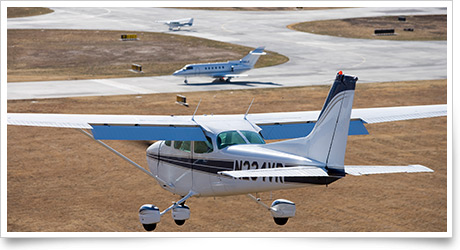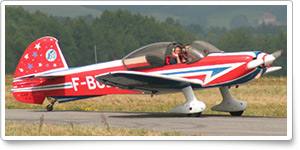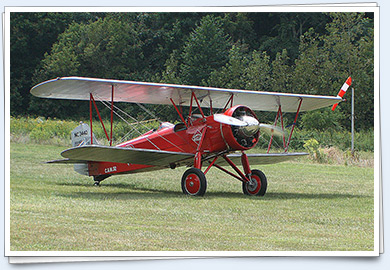Oct. 12, 2012, issue of 'AOPA ePilot: Flight Training Edition' weekly newsletter
| ||||||
| An unfamiliar entry |
| |||||
Training TipsAn unfamiliar entry
As often happens when someone raises a question about traffic patterns, advice, commentary, and critique flowed in. It also reignited some perennial debates on the subject.
The focus of the dialog was to assess the legitimacy of an offbeat entry (not necessary to be described here). Another way to examine the issue would be to ask yourself if you are mentally prepared for a pattern encounter with an aircraft that shows up in the “wrong” place.
Don’t let your expectations of what another aircraft should be doing blind you to its actual position, altitude, or heading. If you have ever ridden as an observer on another student’s training flight, or with a pilot friend, you may have noticed that traffic patterns vary widely (pun intended), even among pilots who sat through the same ground school classes.
Flying your pattern by the book—that is, predictably—is a good start. Monitoring the common traffic advisory frequency long before takeoff or arrival in the pattern will help you visualize traffic, but allow for the presence of no-radio aircraft.
Broadcasting your intentions clearly—including stating your airport’s name, particularly on a shared CTAF—is another see-and-avoid best practice.
Use your landing light, day or night, as recommended under the pilot safety program Operation Lights On. That will help you be seen by a pattern interloper. Other collision-avoidance techniques are discussed in this Air Safety Institute safety advisor.
Check for any airport-specific procedures in effect, such as the right-hand traffic pattern for Runway 26, and other procedures prescribed for this California airport.
Take current flight conditions into account when scanning for traffic. Suppose there is a 20-knot breeze blowing down the runway. Would you fly as far downwind as on a calm day? That might lessen your chance of making the runway after an engine failure (as your flight instructor might promptly demonstrate).
There’s no end to the surprising “methods” you may hear about in the coffee shop or the pilot’s lounge. If the impact of that realization is to heighten your appreciation of the need for caution in the pattern, you will be forearmed, and alert. Flight Training NewsNall report examines 2010 accident dataFuel management issues continue to plague pilots as the number of fuel management accidents on fixed-wing, noncommercial flights increased for two years in a row, according to the latest Joseph T. Nall Report from the Air Safety Institute. The report’s findings are based on 2010 accident data—the most recent year for which enough data are available to be statistically valid and give a complete safety picture. Read more >> AOPA unveils Center to Advance the Pilot CommunityAOPA has launched the Center to Advance the Pilot Community, intended to arrest a decline in the pilot population. The center, led by Senior Vice President Adam Smith, will focus on projects that have clear, measurable outcomes. The first major initiative will be to support the development of a network of flying clubs. Read more >> New volunteer pilots course debutsHave you ever thought about using your flying skills to help others by becoming a volunteer pilot? Learn what it takes with the Air Safety Institute’s Public Benefit Flying: Balancing Safety and Compassion online course. Flight profiles and interactive decision-making scenarios quickly help you understand how volunteer flying demands professionalism and responsibility—far beyond that of a leisurely personal flight. The course was produced with the generous support of Welles Murphey Jr., the Air Care Alliance, and the AOPA Foundation. Embry-Riddle equips trainers with noise-reduction equipmentEmbry-Riddle Aeronautical University, Daytona Beach, Fla., has installed noise reduction exhaust systems on all 41 Cessna 172s in its training fleet, according to a news report. The Daytona Beach News-Journal said that ERAU spent five years and $250,000 researching the issue of noise reduction and continues to research quieter propellers. The Daytona Beach campus averages about 250 training flights per day. Taking to the streetsWas that an airplane that just taxied past your window? Residents of Palm Springs, Calif., were treated to an unusual sight Oct. 10: a series of airplanes traveling under their own power from Palm Springs International Airport to the convention center for AOPA Aviation Summit. From the grass-strip-ready 2012 Tougher Than A Tornado Sweepstakes Husky to the sleek Phenom 100, the assortment of aircraft strutting down the city streets turned heads. Some familiar airframes made appearances, including sweepstakes airplanes of years past. Read more and view the slideshow >> Cornerstone of a safe flightThe Private Pilot Practical Test Standards now include an increased focus on a pilot’s decision-making skills. Do you have what it takes? Read about the situations other pilots have faced, and their decisions. Visit the Air Safety Institute’s Aeronautical Decision Making Safety Spotlight. Flight school opens in Tallahassee, Fla.A new flight school has opened at Tallahassee Regional Airport in Tallahassee, Fla. FL Aviation Center held a grand opening on Sept. 29, and owners Faith Drewry and Lacey Mayer said they already have 360 names on a mailing list. The school currently offers a Cessna 172 and Piper Warrior, with plans to add a Cessna 152 and an American Champion Decathlon, according to Tallahassee.com. More information on the school is available on its Facebook page. Pennsylvania flying club celebrates eightieth yearThe Reading Aero Club, based at Reading Regional Airport in Pennsylvania, will celebrate its eightieth anniversary Oct. 20. The club is among the oldest continuously operating flying clubs in the United States. The 44 members currently share a Piper Cherokee 180 and a Cessna 172SP. The club has owned 34 aircraft over the years. Olin Marth, the club president, said the financial system is one secret to the club’s longevity: “We track our operating costs real time, both fixed and variable, and know when we must adjust our cost to fly or dues to match current conditions.” Admission is free, trophies will be awarded for cars and airplanes, and free birthday cake for all. Training Resources“Any traffic in the pattern, please advise.” “Tally ho.” You will hear phrases on the radio that don’t quite sound legitimate. The Aeronautical Information Manual (AIM) is the best reference for learning good ATC communication skills and phraseology. AOPA’s aviation subject report on radio communications can help you too.
Did you know that student pilots who join AOPA are three times more likely to complete their flight training? Membership includes unlimited access to aviation information by phone (800/USA-AOPA, weekdays from 8:30 a.m. to 6 p.m. Eastern time) or from Flight Training Online or AOPA Online. If you’re not already a member, join today and get the pilot’s edge. Login information is available online. Critical information: The passenger safety briefing Career PilotDelta begins making jet fuelDelta Air Lines began producing jet fuel the week of Sept. 24 at the Pennsylvania refinery it purchased earlier this year, sources told Reuters. Delta bought the 185,000-barrel-per-day refinery, which had been shut down in September 2011, from Phillips 66 in an effort to control its fuel costs. The carrier believes that the refinery, when fully operational, will reduce its annual fuel bill—some $12 billion in 2011—by $300 million. United employees earn bonuses for on-time performanceUnited Airlines announced Oct. 1 that it exceeded its percent on-time domestic performance goal for the month of September, and is rewarding eligible employees with a $50 on-time bonus. The airline said it ended the month with an 82-percent domestic on-time arrival rate, showing continued significant improvement from the prior months. “I thank my co-workers for their focus on returning us to running an on-time airline,” said Jeff Smisek, United president and CEO. “As a result of their hard work and our improved performance, we're seeing much higher customer satisfaction.” Plane SpotterSnap decision: Mudry CAP 10 Training ProductsStudent flight record for instrument and commercial pilots from ASAAviation Supplies & Academics has updated its Student Flight Record for instrument and commercial pilots to comply with the new Commercial Pilot Practical Test Standards for single- and multiengine land and sea, as well as changes to the Instrument Pilot Practical Test Standards. The four-panel folder-style record can be used to track students enrolled in instrument, commercial, instrument flight instructor, or a combined instrument/commercial course. The record satisfies Part 61 and Part 141 requirements. Each record is $2.95. Records also are available for private pilot-airplane and private/commercial/instrument-helicopter. For more information, see the website or call 800/272-2359.
Note: Products listed have not been evaluated by ePilot editors unless otherwise noted. AOPA assumes no responsibility for products or services listed or for claims or actions by manufacturers or vendors. Member BenefitsThe big C: Medical certification for prostate or breast cancerIf you have been treated for prostate or breast cancer, an aviation medical examiner can’t give you a special issuance medical. You must gather all your medical records, evaluations, and test results, and bring those to the AME, who must then get permission to issue the medical from FAA staff. Dr. Warren Silberman discusses the need for accurate, complete paperwork and what you can expect. Read more >> AOPA offers options for term life insuranceAOPA has such a diverse membership that there is not one insurance program that is best for all members. That’s why AOPA offers three distinct options when it comes to securing term life insurance to provide for your family’s needs if something happens to you. Read more >> BlogsCFIs: Are these students talking about you?“Loves to teach.” “Exceptional.” “Has exciting new ideas for teaching.” These are the attributes of the Flight Training Excellence Award’s Outstanding Flight Instructors—but could they also apply to you? Also in the Flight Training blog, professional pilot Chip Wright describes certain procedures in which a do-it-now approach is expected. Strange but true general aviation newsA pilot records everything on an iPad while his airplane goes down in the Gulf of Mexico, a driver thinks he hears an airplane crash and reports it to a local sheriff, and much more from Benét Wilson in the Reporting Points blog. AOPA Career OpportunitiesEver dream of turning your passion for aviation into a career? We’re looking for a strategy and financial analyst, executive assistant, director of media relations, major gifts officer, and Web graphic designer. To learn more about other AOPA career opportunities, visit AOPA Online. Community
AVIATION EVENTS & WEATHER
| ||||||||||||||||||||||||||||||||||||




 A casual conversation between two pilots raised questions when one described a method of airport traffic pattern entry that was unfamiliar to the other. Efforts to look it up in standard FAA reference material failed. That’s when the curious pilot
A casual conversation between two pilots raised questions when one described a method of airport traffic pattern entry that was unfamiliar to the other. Efforts to look it up in standard FAA reference material failed. That’s when the curious pilot 




